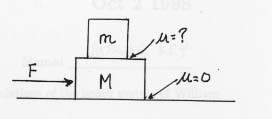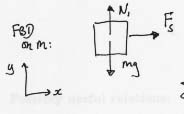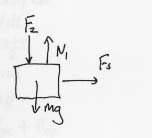Problem 4:
-
4)
 A box of mass m is sitting on top of another box of mass
M, which
sits on a (frictionless) layer of ice. There is friction between the
two boxes. A horizontal force of magnitude F is applied to the lower
box (see diagram).
A box of mass m is sitting on top of another box of mass
M, which
sits on a (frictionless) layer of ice. There is friction between the
two boxes. A horizontal force of magnitude F is applied to the lower
box (see diagram).
- a) Assume that the static friction is such that the two boxes move
together. What is the acceleration of the system?
- b) what is the minimum coefficient of static friction between the
two boxes such that they move together?
- c) Now, assume that something is exerting an addtional vertical
(downwards) force F2 on the upper box.
What would now be the minimum
coefficient of static friction such that the boxes move together?
Solution:
-
a) This is very similar to one of the homework problems. If the two masses
move together, we can consider them as one system of
mass (m + M); we have
-
 F = (m + M)a
F = (m + M)a
- or
- a = F/(m+M)
- b) The frictional force is the force that causes the upper mass to
have acceleration a. Draw a force diagram for this mass,
with the coordinate system shown:

- Apply
 F = ma
F = ma
to this mass:
- x-component: Fs = m a
- y-component: N - mg = 0
- where N is the normal force and Fs the (static) frictional
force. We have Fs <= µsN,
but since we are interested in the minimum coefficient we can
set Fs = µsN. The y-equation gives
- N = mg
- and so the x-equation gives
- Fs = µsN = µsmg = ma
- or, solving for µ,
- µ = a/g = F/[g(m+M)]
- where we have substituted in the result from a).
- c) The force diagram is now:
 :
:
- Everything proceeds the same as in part b), with one
additional force:
- x-component: Fs = m a
- y-component: N - mg - F2= 0
- The y-equation gives
- N = mg + F2
- and so the x-equation gives
- Fs = µsN = µs(mg + F2) =
ma
- or, solving for µ,
- µ = ma/(mg+F2) = mF/[(mg+F2)(m+M)]
- The required frictional coefficient is reduced, since we have
increased the normal force.
Test 1
Physics 101 Home page
Physics Department Home Page
College of William and Mary,
Dept. of Physics
armd@physics.wm.edu
last updated: Oct 2 1998
 A box of mass m is sitting on top of another box of mass
M, which
sits on a (frictionless) layer of ice. There is friction between the
two boxes. A horizontal force of magnitude F is applied to the lower
box (see diagram).
A box of mass m is sitting on top of another box of mass
M, which
sits on a (frictionless) layer of ice. There is friction between the
two boxes. A horizontal force of magnitude F is applied to the lower
box (see diagram).  A box of mass m is sitting on top of another box of mass
M, which
sits on a (frictionless) layer of ice. There is friction between the
two boxes. A horizontal force of magnitude F is applied to the lower
box (see diagram).
A box of mass m is sitting on top of another box of mass
M, which
sits on a (frictionless) layer of ice. There is friction between the
two boxes. A horizontal force of magnitude F is applied to the lower
box (see diagram). 
 :
: